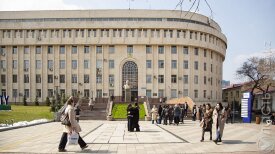Читайте этот материал на русском.
In 2024, the total volume of transfers from the Kazakhstan National Fund may hit a 10-year high. Presidential orders, on top of a widening deficit in the state budget, have demanded additional funding, resulting in the National Fund covering 20% of this year’s government expenses.
These financial withdrawals have continued to grow over the past few years, posing Kazakhstan with a problem: The gradual depletion of National Fund assets in the near future. Vlast analyzed just what exactly this crisis could entail.
Last week, Azamat Amrin, the deputy minister of economy, stated that Kazakhstan must withdraw an extra 2 trillion tenge ($4.2 billion) from the National Fund to finance this year’s budgetary deficit.
This is the second unplanned request to access the National Fund’s assets this year. The first request was the decision to purchase a 12% stake in Kazatomprom worth 467.4 billion tenge in July ($970 million at the time).
As a result, the total volume of transfers in 2024 has reached 6 trillion tenge ($12.5 billion), despite officials planning to cap 2024 transfers at 3.6 trillion tenge ($7.5).
Withdrawals have only continued to grow, despite calls from both the president and government to limit them in an effort to reach the ambitious goal to increase the National Fund’s assets to $100 billion by 2030.
To achieve the president’s objective, the government established limits on guaranteed transfers from the National Fund back in 2022. Officially, this contained the total volume of transfers in 2023, which shrank by 600 billion tenge ($1.3 billion).
However, in that very same year, the government urgently transferred 1.3 trillion tenge ($2.7 billion) from the National Fund. The withdrawal took the form of another purchase: in December 2023, the ministry of finance obtained a 20% stake in Kazmunaigas. Effectively, last year’s total volume of withdrawals from the National Fund totaled a staggering 5.3 trillion tenge ($11 billion).
From 2013 to 2024, a total of 38 trillion tenge has been diverted from the National Fund into the state budget. Since 2020, the annual volume of withdrawals has consistently exceeded 4 trillion tenge ($8.3billion).
High oil prices have contributed to the Fund’s income from the proceeds of the country’s major oil projects. Despite this seemingly favorable situation, the National Fund’s assets have continued to decrease in the past few years. By August 2024, their value had declined to $60 billion, tumbling from a peak of $77.2 billion in August 2014.
This can be explained by the global crises that have also affected the country. For example, reduced tax revenues from oil and gas companies have facilitated this decline. But there’s another reason for the shortfall.
Initially, the National Fund was designed to collect extra oil revenues for future generations, as well as to finance the budget during economic crises.
The government made use of the Fund’s assets during the 2008 global financial crisis, which hit Kazakhstan’s banking sector the hardest. National Fund assets were also used to counteract the 2015 geopolitical crisis and to finance state responses to the COVID-19 pandemic. Since then, however, in addition to those extraordinary measures, the government also used National Fund assets to fulfill campaign promises and annual presidential orders.
These orders have inflated the government expenses, increasing the budgetary deficit. The National Fund became the primary source of financing to cover the shortfall. According to data obtained from the ministry of finance, the budget deficit was approximately 2.2 trillion tenge ($4.6 billion) in 2023. However, according to Halyk Finance analysts, the budget deficit would have climbed to 11.6 trillion tenge ($24 billion) without transfers from the National Fund.
Transfers from the National Fund continue to increase due to the government’s failure to meet expectations: the volume of taxes collected have not kept pace with yearly plans. Meanwhile, government spending has skyrocketed to support the economy, infrastructure, social spending, and servicing the national debt. Over the past three years, transfers from the National Fund have covered 20% of all budgetary expenses.
But how effective is the investment of National Fund assets into the economy? Experts say it is not. Rather, these capital injections have gone to support enterprises and organizations that do not provide comparable returns in terms of economic growth, taxes, or employment.
And how realistic is Kazakhstan’s ambition to increase National Fund assets to $100 billion? Most experts believe that this goal would soon turn into a more realistic plan to maintain assets at least at $50 billion.
Social spending will likely increase in the future. And the government has yet to come up with a clear solution as to ensure commensurate growth in budget revenues, as the country’s population grows while quality of life declines.
Technically, the government and the Central Bank can artificially increase National Fund assets. They could do so by manipulating the securities of national companies, as demonstrated by Kazmunaigas and Kazatomprom. They could buy stakes in national companies at a discount more often, while showing their inflated value in the National Fund’s accounts.
But how expensive and marketable will these shares be, especially since state-owned companies are overburdened by loans?
The emptying of the National Fund confronts Kazakhstan with several major problems. The government will not be able to maintain the current volume of expenses devoted to the financing of national development projects. Should the Fund run out of money, even basic spending on infrastructure, education, medicine, and pensions will become a contentious problem.
The National Fund also often serves as a source of state guarantees for infrastructure and economic projects that Kazakhstan develops alongside international organizations.
With a weaker National Fund, it could become increasingly difficult for the government to not only realize these projects, but also to repay the loans supporting them.
In the worst possible scenario, a default on these obligations would spark a full-fledged economic crisis.
This article was translated into English by Daniella Marx.
Поддержите журналистику, которой доверяют.








